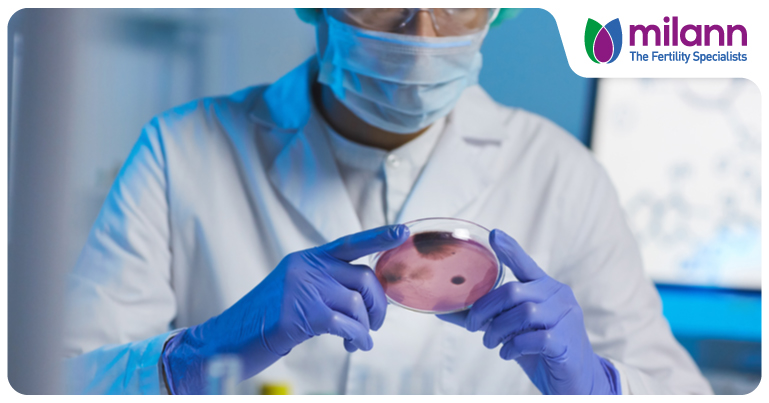Hearing the word “procedure” in the context of fertility can feel overwhelming. For many women, the thought of hysteroscopy brings with it a mix of hope, anxiety, and questions. Will it hurt? How long will recovery take? Are there risks? These feelings are natural, and the good news is that hysteroscopy is one of the safest and simplest procedures in reproductive medicine. By understanding what happens after the procedure, the recovery process, and the minimal risks involved, you can approach it with confidence and peace of mind.
At Milann, we believe that awareness is the first step toward empowerment. When you know what to expect, the uncertainty lessens, and the journey feels less intimidating.
What Happens Immediately After a Hysteroscopy?
Hysteroscopy is a minimally invasive procedure that allows doctors to look inside the uterus using a thin, lighted telescope-like device. Depending on whether it was done for diagnosis or treatment, the recovery process may vary slightly.
Most women are able to go home the same day. Immediately after the procedure, it’s normal to feel mild cramping, light spotting, or fatigue. Some patients compare the sensation to period-like cramps. These effects usually subside within a day or two. If anesthesia was used, you may feel drowsy, and doctors recommend resting for the remainder of the day.
This early recovery phase is more about rest than restriction. Many women are back to work or routine activities within 24 to 48 hours, although strenuous exercise or heavy lifting is best avoided until your doctor gives the go-ahead.
The Typical Recovery Timeline
Recovery after hysteroscopy is usually smooth and relatively quick. Within the first few days, mild discomfort may persist, but it is often managed with simple pain relief and rest. Spotting or light bleeding can continue for a few days but should taper off naturally.
By the end of the first week, most women feel completely normal again. For those who underwent a therapeutic hysteroscopy, such as removal of polyps, fibroids, or adhesions, the recovery may be slightly longer depending on the extent of the treatment. Even then, most patients resume their usual lifestyle within a week.
Emotional recovery is just as important. For women undergoing fertility evaluations, the period after a hysteroscopy can bring a mix of relief at having answers and impatience to move on to the next step. It’s important to allow your body and mind the space to heal before diving back into fertility treatments.
Understanding Possible Risks and Complications
Like any medical procedure, hysteroscopy does come with some risks, though they are rare. These may include infection, excessive bleeding, or injury to the uterus. In most cases, these complications are minimal and manageable, especially when the procedure is performed by experienced fertility specialists.
Dr. Sunitha Mahesh, a fertility expert at Milann, explains:
“One of the most reassuring aspects of hysteroscopy is its safety profile. Complications are extremely rare, and when performed in a specialized setting, the benefits far outweigh the risks. For many women, it is the key step that unlocks answers to years of unanswered fertility struggles.”
This perspective is crucial. Understanding the small risks helps patients feel prepared, but also reassured that in expert hands, hysteroscopy is safe and effective.
Aftercare Tips and Follow-Up Guidance
The days after hysteroscopy are a chance to focus on gentle recovery. Most doctors recommend avoiding intercourse, tampons, or swimming for about a week to lower the risk of infection. Staying hydrated, resting adequately, and listening to your body are small but important steps.
Follow-up appointments are a key part of the process. They allow your doctor to discuss what the hysteroscopy revealed, whether any treatment was completed during the procedure, and the next steps in your fertility journey. This is often the moment where answers replace uncertainty, and a clear path forward begins to take shape.
If hysteroscopy was part of a fertility evaluation, the results may directly guide your treatment plan, whether that means correcting a uterine abnormality, moving ahead with IVF, or exploring other options.
Why Choose Milann for Hysteroscopy?
At Milann, hysteroscopy is not just a procedure, it is part of a holistic approach to understanding and
treating infertility. From state-of-the-art technology to compassionate aftercare, our specialists ensure that every patient feels supported through recovery and beyond.
We combine clinical expertise with emotional care because we understand that fertility is not just about the body but also about hope, patience, and resilience.
Book A Consultation With Milann
Hysteroscopy may sound intimidating at first, but it is often the simplest step toward solving complex fertility problems. Recovery is usually smooth, risks are minimal, and the insights gained are invaluable in creating a clearer, more personalised treatment plan. If you are preparing for hysteroscopy or still weighing your options, remember that you don’t have to navigate this journey alone. With the right guidance and support, this procedure can be the bridge between uncertainty and possibility.
Take the next step with confidence, Milann’s experts are here to guide you through hysteroscopy care and beyond, ensuring that your fertility journey is as safe, transparent, and hopeful as possible.
Reviewed by
Dr. Sunitha Mahesh Medical Director & Senior consultant - Infertility and maternal Fetal medicine J P Nagar, HSR Layout.
